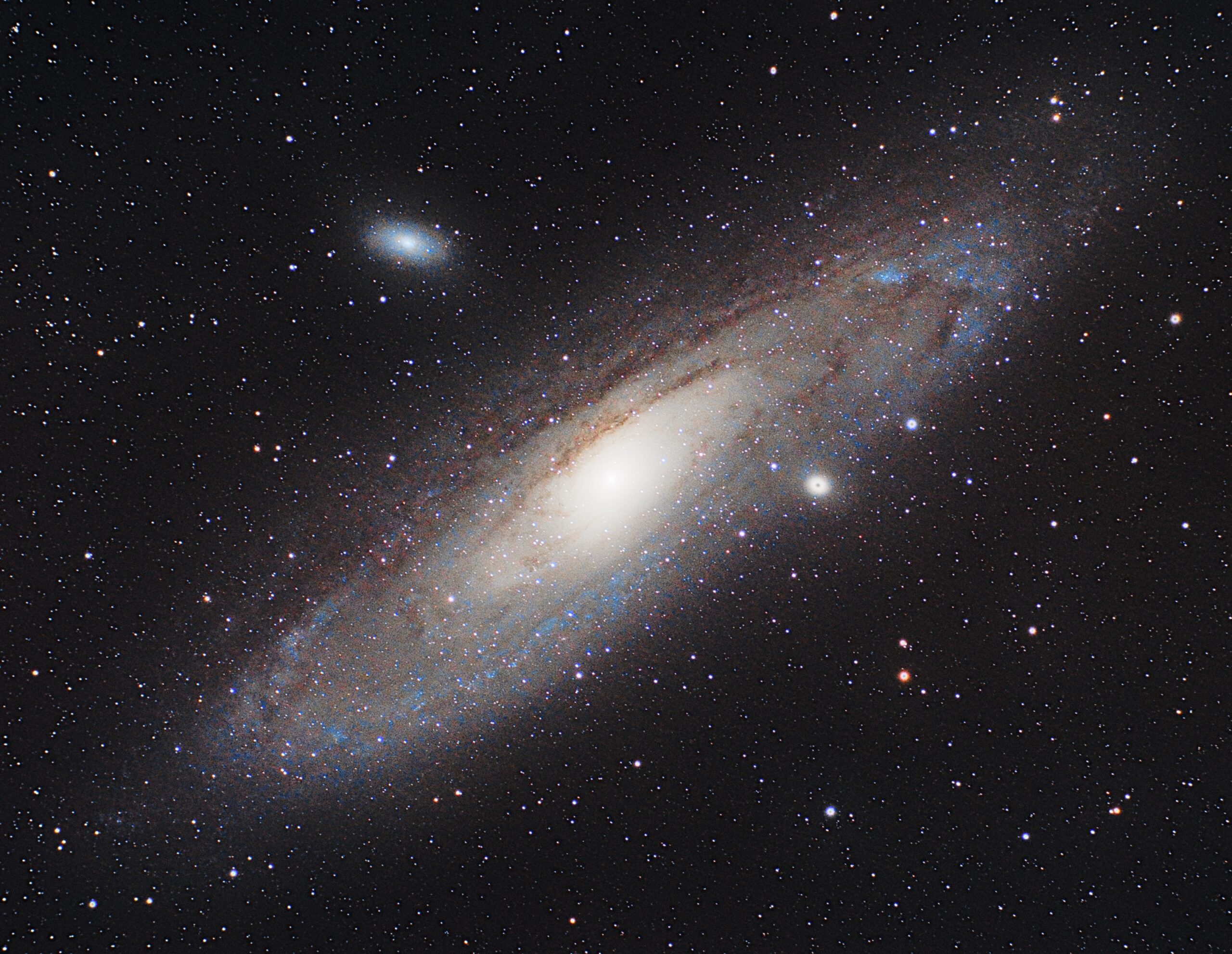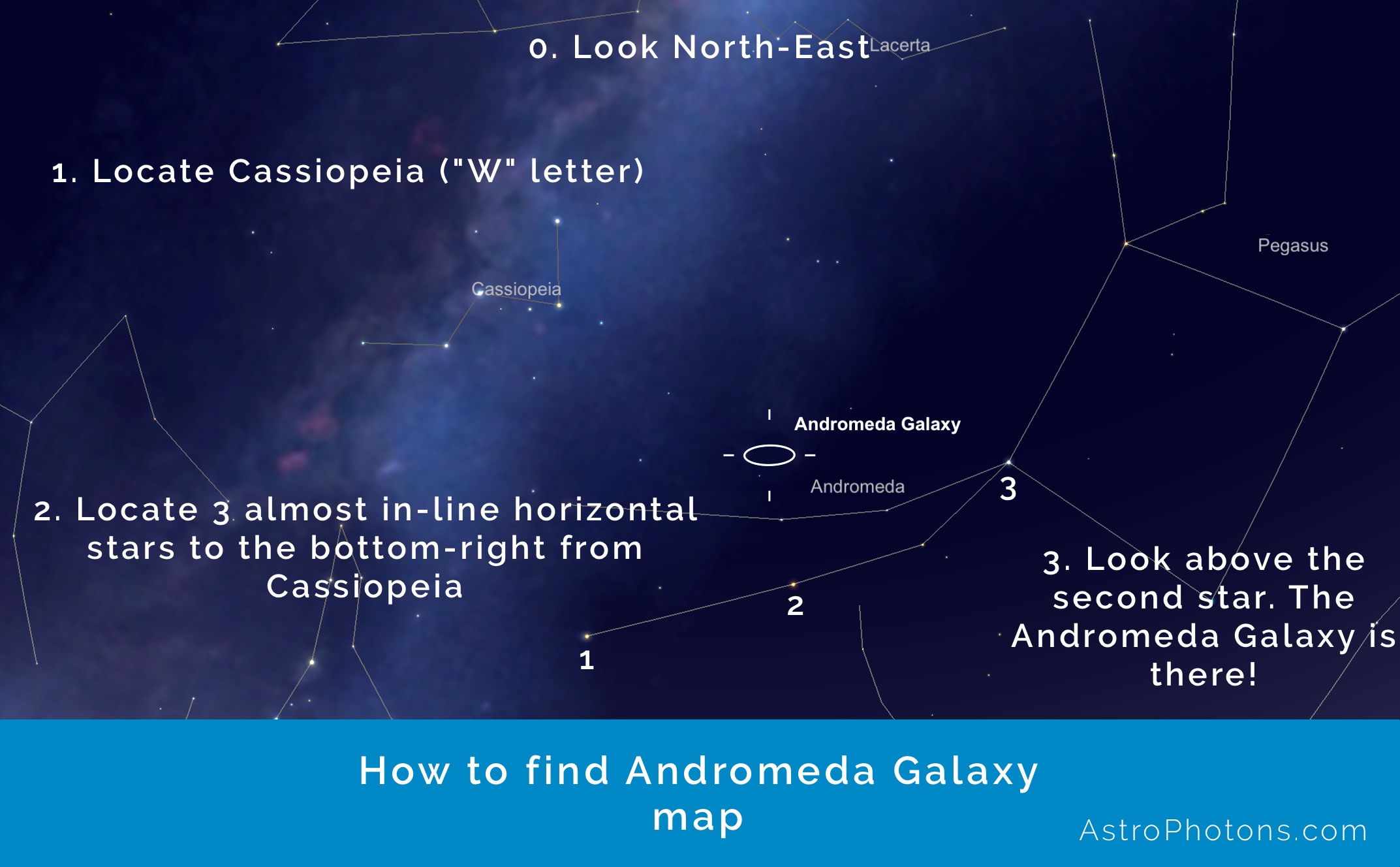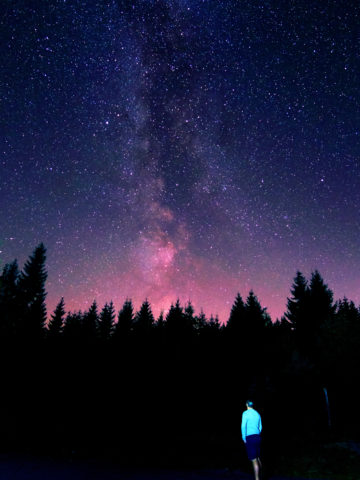Andromeda Galaxy is one of the most popular fall astrophotography targets worldwide, and no wonder! It's beautiful, bright, and easy to locate in the night sky. If you are a complete beginner in the astrophotography field but would love to take a picture of our neighboring galaxy using a DSLR/mirrorless camera and a telephoto lens or a telescope, here you have the complete guide to photographing the Andromeda Galaxy. P.S. If you are looking for more beginner-friendly astrophotography targets, check out my free astrophotography ebook.

Jump to:
- Andromeda Galaxy Facts
- How to Find the Andromeda Galaxy (Location on Sky)
- Andromeda Galaxy Visibility During the Year
- Andromeda Galaxy Through a Telephoto Lens
- Astrophotography Equipment for Photographing the M31
- Andromeda Galaxy Photography Settings
- My Progress in Photographing the Andromeda Galaxy
- Links
- 💬 Comments
Andromeda Galaxy Facts
The Andromeda galaxy is our nearest spiral galaxy neighbor, but the closest galaxy in general to our own is the Canis Major Dwarf Galaxy. Also, the M31 is one of the brightest objects in the night sky, meaning you can photograph it quickly (in minutes, not hours).
Yes, even with naked eyes, if you are in a dark place (outside of the city). A pair of good astronomy binoculars is helpful but not mandatory.
| Object | Andromeda galaxy |
| Object type | Spiral galaxy |
| Other names | M31, Messier 31, NGC 224 |
| Constellation | Andromeda |
| RA (right ascension) | 00h 42m 44.3s |
| DEC (declination) | +41° 16′ 9″ |
| Magnitude | 3,44 |
| Angular size | 178 × 63 arcmin |
| Age | 10 billion years |
How to Find the Andromeda Galaxy (Location on Sky)
The M31 is located in the constellation Andromeda, close to Perseus and Cassiopeia. Finding it is quite easy as the M31 is visible to the naked eye (outside of the city). You can easily observe the Andromeda Galaxy using binoculars.

If you are unfamiliar with the night sky, I recommend you use software to help you locate astronomical objects. For iPhone and iPad users, I have my astronomy apps for iPhone compilation. If you are not an Apple user, you can use multi-platform apps like Stellarium.
Andromeda Galaxy Visibility During the Year
The M31 is close to the Polaris, meaning is visible almost all year round! Yet the best time to photograph it in the Northern Hemisphere is from late Summer to Winter when the galaxy is high in the sky. Generally, the lower the designated photography object is in the sky, the more work you will have in post-processing and the worse your effects. Higher objects in the sky = less atmosphere and less light pollution. So reserve some time from August to December and shoot the Andromeda galaxy then.
Andromeda Galaxy Through a Telephoto Lens
The biggest surprise for many people is that you don't need to use a telescope to photograph the Andromeda Galaxy! Of course, if you have a small refractor scope, you can use it, and the final picture resolution will be higher. But to reveal some details of the Andromeda Galaxy, the only optics you need is a telephoto lens!

Astrophotography Equipment for Photographing the M31
Camera
Cooled, expensive astronomical CCD cameras are not needed! Thanks to its brightness, Andromeda galaxy is a perfect astrophotography target for simple DSLR and mirrorless cameras. Almost every Canon, Nikon, Fuji, Olympus, Panasonic, and many other cameras from this decade can perfectly capture this galaxy. So don't rush to the photo store; use what you already have.
If you don't yet have any photography gear and are looking for some advice, check out my beginner astrophotography equipment guide.
Lens
As I said, you don't have to have a telescope to photograph the Andromeda galaxy. Of course, it all depends on the level of detail you want to capture. The longer the focal length, the more significant "zoom" you have. But to photograph some level of detail, I recommend a minimum 90mm lens.

Equatorial Mount
Using the astrophotography "500 rule" and, let's say, a 100mm lens, theoretically, you can photograph the M31 without an equatorial mount. Calculate exposure time (500/100 = 5s), set a very high ISO, and you are done. But the truth is, you won't capture any details on such a short exposure time like this. Unfortunately, you need an equatorial mount to take a good photo of the Andromeda Galaxy with a DSLR or a mirrorless camera.
I use the Fornax Lightrack II mount, but you can select from many other entry-level options, including iOptron SkyTracker, Sky-Watcher Star Adventurer (or a Mini version), or AstroTrac 360.
A Stable Tripod
I used a cheap tripod for my wide-field (135mm) deep-sky astrophotography. In quiet, non-windy conditions, it worked. But any slight breeze appeared, and my exposures were blurred. Today I use a very stable Manfrotto 475B, and those annoying nights are gone.
An Intervalometer (Optional)
To take a high-quality astro picture, you must stack many exposures into one frame. You can do, let's say, 40 exposures manually. But you can plug an intervalometer into your camera, program it to take the exposures you want, and chill on the chair and watch the night sky when your rig is photographing on autopilot for you. I highly recommend using an intervalometer for any astrophotography work.
Andromeda Galaxy Photography Settings
Generally, camera settings for deep-sky astrophotography depend on many factors:
- Camera's sensor noise
- Lens focal length
- Lens aperture
- Equatorial mount Periodic Error
- Guiding
I cannot tell you what exact settings you should set for your camera. But I can give you a starting point to experiment with:
| Exposure time | 2 minutes (120 seconds) |
| ISO | 800 |
| Aperture | 2.0 |
If you have a 2.8 lens, set ISO to 1600 OR extend the exposure time to 4 minutes (240s). Also, check twice that you shoot in the RAW mode; that way, you will get the maximum quality. JPGs are not as good as RAWs.
My Progress in Photographing the Andromeda Galaxy




Andromeda Galaxy through a telescope
As you can have excellent results with a telephoto lens, using a small APO telescope will set the game to a whole new level.


Links
My Fuji X-T20 Astrophotography Review
Andromeda, as seen by the Hubble Space Telescope on ESA






abdo
I'm buying m21 for long exposure astrophotography and I'm wondering if I got the m31 would it make a noticeable difference
m21 camera
48 MP, f/2.0, 26mm (wide), 1/2.0", 0.8µm, PDAF
m31 camera
64 MP, f/1.8, 26mm (wide), 1/1.72", 0.8µm, PDAF